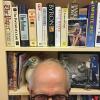Underground Anomalies: Archaeologist Dismisses Fears of Unmarked Graves
Pub Notes

Harold Rittenberry's gate welcomes visitors to Brooklyn Cemetery.
Catherine and Lam Hardman live in a secluded home on the short, dead-end street, Harwood Court, off West Lake Drive, behind Holy Cross Lutheran Church, down the hill from Brooklyn Cemetery. When they bought their house, they also tried to buy the lot between them and the cemetery but couldn’t work it out. That lot was bought a couple of years ago, and construction will begin on a new house right up next to the Hardmans’ shallow backyard.
When they learned of the proposed construction, the Hardmans were alarmed because of the proximity of Brooklyn Cemetery and the possibility that there might be graves outside the cemetery boundary, a not-unusual occurrence. The Hardmans raised the alarm that construction of the house might disturb old, unmarked graves, a sore subject locally, following the massive discovery of unmarked African-American graves adjacent to the Old Athens Cemetery on the UGA campus recently. Brooklyn Cemetery is an abandoned Arican-American burial ground, which the trustees, Friends of Brooklyn Cemetery, are slowly restoring.
The Hardmans’ concerns about graves were dismissed as having no proof, so they hired Len Strozier, owner of Omega Mapping Service, to examine their own lot to see if any graves could be found. Their assumption was that if there were graves on their lot, it would stand to reason that the adjacent lot, which runs right up to the cemetery, would be even more likely to contain gravesites.
Strozier used “ground penetrating radar,” a sonar-like device that detects underground objects and disturbances of the soil. Much of his work involves mapping cemeteries and discovering cemeteries where construction is planned or has already occurred. Strozier found numerous suspected gravesites on the Hardman property, and he strayed over the line onto the adjacent lot and marked numerous suspected gravesites there also.
Strozier says that in the case of 125-year old graves there may be nothing left but an air pocket, which can frequently be invaded by tree roots. He marked all the anomalies detected by his GPR with pink flags, and the Hardmans went to the planning department with their newfound evidence.
Planning Director Brad Griffin says that at that point no permits had been issued, so he put a hold on the property and directed the owners, Norm and Karen Baldwin, to have their own tests made. The Baldwins hired local firm Southeastern Archeological Services, which had been heavily involved in the location and exhumation of the remains outside Old Athens Cemetery.
In his report to the planning director, Tom Gresham, principal investigator for Southeastern, categorically dismissed Strozier’s findings.
“Working with other professional archaeologists I have concluded that it is unlikely that graves exist anywhere on the parcel, and that it is highly unlikely that graves exist within the footprint of the house that is proposed to be built.”
Southeastern probed the sites marked by Strozier and found no evidence of graves. In the presence of cemetery trustees, along with the trustees’ own consulting archaeologist, Southeastern used a backhoe to dig down into one of the possible gravesites marked by Strozier and found no evidence of ground disturbance below the topsoil. Then Southeastern conducted its own ground-penetrating-radar examination of the house footprint and found no evidence of grave sites.
Based on Southeastern’s meticulous three-page report, Griffin says that the Baldwins complied with all the planning department’s requirements, and there was no reason not to issue a building permit for their new home.
The question still sort of hangs in the air as to how two different professionals using the same kind of equipment could come up with diametrically opposed results on such a sensitive subject. Southeastern’s Gresham concludes his report pretty much as it began. “In conclusion, it is my professional opinion that the various methods employed… have shown that there is no evidence for graves anywhere on the lot, and especially not within the proposed footprint of the house. It is my conclusion that no graves will be disturbed by the proposed construction of the house.”
Strozier’s assessment differs.
“In a sentence, it’s a difference in scope. My job was to find graves. Their job was not to find graves. I was there to find anything, and they were there to find King Tut’s tomb.”
Keywords
More by Pete McCommons
-
Voting Absentee: Necessary But Not Easy
Pub Notes
-

Be Ready When National TV Comes Calling
Pub Notes
-










comments